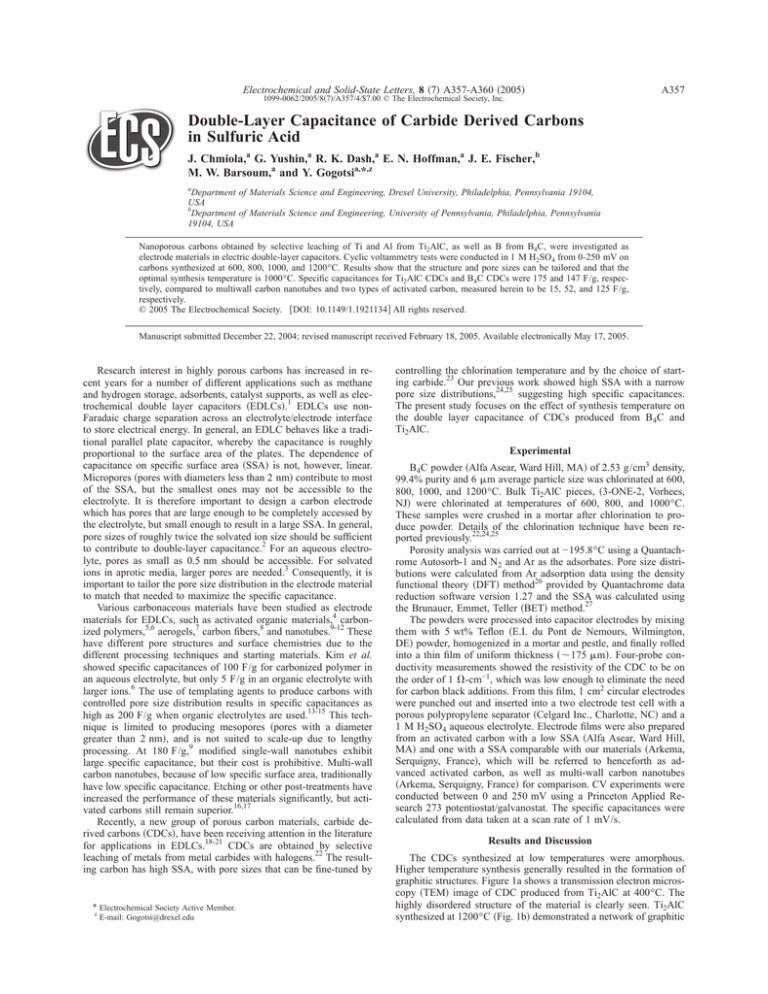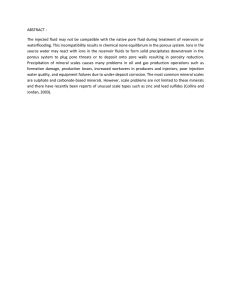
Electrochemical and Solid-State Letters, 8 共7兲 A357-A360 共2005兲
A357
1099-0062/2005/8共7兲/A357/4/$7.00 © The Electrochemical Society, Inc.
Double-Layer Capacitance of Carbide Derived Carbons
in Sulfuric Acid
J. Chmiola,a G. Yushin,a R. K. Dash,a E. N. Hoffman,a J. E. Fischer,b
M. W. Barsoum,a and Y. Gogotsia,*,z
a
Department of Materials Science and Engineering, Drexel University, Philadelphia, Pennsylvania 19104,
USA
Department of Materials Science and Engineering, University of Pennsylvania, Philadelphia, Pennsylvania
19104, USA
b
Nanoporous carbons obtained by selective leaching of Ti and Al from Ti2AlC, as well as B from B4C, were investigated as
electrode materials in electric double-layer capacitors. Cyclic voltammetry tests were conducted in 1 M H2SO4 from 0-250 mV on
carbons synthesized at 600, 800, 1000, and 1200°C. Results show that the structure and pore sizes can be tailored and that the
optimal synthesis temperature is 1000°C. Specific capacitances for Ti2AlC CDCs and B4C CDCs were 175 and 147 F/g, respectively, compared to multiwall carbon nanotubes and two types of activated carbon, measured herein to be 15, 52, and 125 F/g,
respectively.
© 2005 The Electrochemical Society. 关DOI: 10.1149/1.1921134兴 All rights reserved.
Manuscript submitted December 22, 2004; revised manuscript received February 18, 2005. Available electronically May 17, 2005.
Research interest in highly porous carbons has increased in recent years for a number of different applications such as methane
and hydrogen storage, adsorbents, catalyst supports, as well as electrochemical double layer capacitors 共EDLCs兲.1 EDLCs use nonFaradaic charge separation across an electrolyte/electrode interface
to store electrical energy. In general, an EDLC behaves like a traditional parallel plate capacitor, whereby the capacitance is roughly
proportional to the surface area of the plates. The dependence of
capacitance on specific surface area 共SSA兲 is not, however, linear.
Micropores 共pores with diameters less than 2 nm兲 contribute to most
of the SSA, but the smallest ones may not be accessible to the
electrolyte. It is therefore important to design a carbon electrode
which has pores that are large enough to be completely accessed by
the electrolyte, but small enough to result in a large SSA. In general,
pore sizes of roughly twice the solvated ion size should be sufficient
to contribute to double-layer capacitance.2 For an aqueous electrolyte, pores as small as 0.5 nm should be accessible. For solvated
ions in aprotic media, larger pores are needed.3 Consequently, it is
important to tailor the pore size distribution in the electrode material
to match that needed to maximize the specific capacitance.
Various carbonaceous materials have been studied as electrode
materials for EDLCs, such as activated organic materials,4 carbonized polymers,5,6 aerogels,7 carbon fibers,8 and nanotubes.9-12 These
have different pore structures and surface chemistries due to the
different processing techniques and starting materials. Kim et al.
showed specific capacitances of 100 F/g for carbonized polymer in
an aqueous electrolyte, but only 5 F/g in an organic electrolyte with
larger ions.6 The use of templating agents to produce carbons with
controlled pore size distribution results in specific capacitances as
high as 200 F/g when organic electrolytes are used.13-15 This technique is limited to producing mesopores 共pores with a diameter
greater than 2 nm兲, and is not suited to scale-up due to lengthy
processing. At 180 F/g,9 modified single-wall nanotubes exhibit
large specific capacitance, but their cost is prohibitive. Multi-wall
carbon nanotubes, because of low specific surface area, traditionally
have low specific capacitance. Etching or other post-treatments have
increased the performance of these materials significantly, but activated carbons still remain superior.16,17
Recently, a new group of porous carbon materials, carbide derived carbons 共CDCs兲, have been receiving attention in the literature
for applications in EDLCs.18-21 CDCs are obtained by selective
leaching of metals from metal carbides with halogens.22 The resulting carbon has high SSA, with pore sizes that can be fine-tuned by
* Electrochemical Society Active Member.
z
E-mail: Gogotsi@drexel.edu
controlling the chlorination temperature and by the choice of starting carbide.23 Our previous work showed high SSA with a narrow
pore size distributions,24,25 suggesting high specific capacitances.
The present study focuses on the effect of synthesis temperature on
the double layer capacitance of CDCs produced from B4C and
Ti2AlC.
Experimental
B4C powder 共Alfa Asear, Ward Hill, MA兲 of 2.53 g/cm3 density,
99.4% purity and 6 m average particle size was chlorinated at 600,
800, 1000, and 1200°C. Bulk Ti2AlC pieces, 共3-ONE-2, Vorhees,
NJ兲 were chlorinated at temperatures of 600, 800, and 1000°C.
These samples were crushed in a mortar after chlorination to produce powder. Details of the chlorination technique have been reported previously.22,24,25
Porosity analysis was carried out at −195.8°C using a Quantachrome Autosorb-1 and N2 and Ar as the adsorbates. Pore size distributions were calculated from Ar adsorption data using the density
functional theory 共DFT兲 method26 provided by Quantachrome data
reduction software version 1.27 and the SSA was calculated using
the Brunauer, Emmet, Teller 共BET兲 method.27
The powders were processed into capacitor electrodes by mixing
them with 5 wt% Teflon 共E.I. du Pont de Nemours, Wilmington,
DE兲 powder, homogenized in a mortar and pestle, and finally rolled
into a thin film of uniform thickness 共⬃175 m兲. Four-probe conductivity measurements showed the resistivity of the CDC to be on
the order of 1 ⍀-cm−1, which was low enough to eliminate the need
for carbon black additions. From this film, 1 cm2 circular electrodes
were punched out and inserted into a two electrode test cell with a
porous polypropylene separator 共Celgard Inc., Charlotte, NC兲 and a
1 M H2SO4 aqueous electrolyte. Electrode films were also prepared
from an activated carbon with a low SSA 共Alfa Asear, Ward Hill,
MA兲 and one with a SSA comparable with our materials 共Arkema,
Serquigny, France兲, which will be referred to henceforth as advanced activated carbon, as well as multi-wall carbon nanotubes
共Arkema, Serquigny, France兲 for comparison. CV experiments were
conducted between 0 and 250 mV using a Princeton Applied Research 273 potentiostat/galvanostat. The specific capacitances were
calculated from data taken at a scan rate of 1 mV/s.
Results and Discussion
The CDCs synthesized at low temperatures were amorphous.
Higher temperature synthesis generally resulted in the formation of
graphitic structures. Figure 1a shows a transmission electron microscopy 共TEM兲 image of CDC produced from Ti2AlC at 400°C. The
highly disordered structure of the material is clearly seen. Ti2AlC
synthesized at 1200°C 共Fig. 1b兲 demonstrated a network of graphitic
A358
Electrochemical and Solid-State Letters, 8 共7兲 A357-A360 共2005兲
Figure 2. 共a兲 Average pore widths calculated using Ar as the adsorbate,
density functional theory and a weighted method which takes into account
contributions of pore volume. 共b兲 Pore size distribution for advanced activated carbon, B4C CDC synthesized at 共c兲 600 and 共d兲 1000°C, and Ti2AlC
CDC synthesized at 共e兲 600 and 共f兲 1000°C.
Figure 1. Representative TEM images of Ti2AlC CDCs synthesized at temperatures of 共a兲 600 and 共b兲 1200°C. Structure of CDC samples depends on
the synthesis temperature. Samples prepared at low temperatures are amorphous; those prepared at higher temperatures contained graphite ribbons.
ribbons mixed in with a more disordered carbon structure. The structure of B4C CDC synthesized in this temperature range was
similar.25 Synthesis of CDC at a temperature of 1000°C resulted in
a more graphitic structure than activated carbon, without a compromise in specific surface area.
Pore sizes for Ti2AlC CDCs24 and B4C CDCs25 calculated using
DFT show that the average pore diameter increases with synthesis
temperature 共Fig. 2a兲. Although the distribution figures 共Fig. 2b-f兲
show multi-modal pore size distributions with minima of zero, this
is an artifact of the DFT model. The actual pore size distribution,
though it may be multimodal, is believed to be more uniform. The
advanced activated carbon PSD 共Fig. 2b兲 exhibits a pore structure
much like B4C CDC synthesized at low temperatures, with an average pore diameter of ⬃1 nm and a fraction of larger pores up to
⬃2.5 nm. The low SSA activated carbon has an average pore size of
⬃0.5 nm. Figures 2c and d are representative of the changes in pore
structure of B4C CDC with synthesis temperature. At 600°C the
total pore volume is comprised largely of microporosity, whereas at
1000°C the pore size distribution widens and shifts to larger average
pore diameters. Ti2AlC CDC has a more pronounced widening of
the pore size distribution at higher synthesis temperatures, with the
1000°C sample having a large fraction of mesopores larger than
2 nm 共Fig. 2f兲.
As shown herein, large SSAs can be obtained for CDCs without
further activation of the carbon product 共Fig. 3兲. In Ti2AlC CDCs,
the SSAs calculated from N2 adsorption increase from ⬃800 m2 /g
after chlorination at 600°C to a maximum of ⬃1550 m2 /g after
chlorination at 1000°C 共Fig. 3a兲. The SSA then decreases as the
chlorination temperature increases most probably due to increasing
graphitization and closing off of small pores of the amorphous carbon B4C CDC has a maximum SSA of ⬃1800 m2 /g after chlorination at 800°C 共Fig. 3b兲. The SSAs of both CDCs are dominated by
pores that are accessible to the aqueous electrolyte ions. The SSAs
of the low SSA activated carbon, advanced activated carbon and
carbon nanotubes were 547, 1225, and 180 m2 /g, respectively.
CV tests were conducted to characterize electrochemical performance. No faradaic reactions were found within the voltage window
of interest for either material 共Fig. 4 and 5兲. B4C CDC synthesized
at faradaic 600°C resulted in a specific capacitance of 95 F/g, increasing to 147 F/g after 1000°C synthesis 共Fig. 4a and 2b兲. The
latter turned out to be the optimum synthesis temperature; at 1200°C
the value dropped to 120 F/g. This trend follows that of the BET
SSA. The observed small deviations may be connected to the incomplete accessibility of the smallest pores to the electrolyte ions.
Ti2AlC CDC’s followed even closer the correlation between capacitance and SSA 共Fig. 4b and 3a兲: synthesis at 600°C resulted in a
specific capacitance of 77 F/g, while at 1000°C it was 175 F/g, the
highest of all materials tested. For comparison, low SSA activated
carbon, advanced activated carbon and carbon nanotubes yielded 52,
125, and 15 F/g, respectively. The low specific capacitance value for
the low SSA activated carbon and nanotube samples correlate with
their low SSAs, ⬃550 and ⬃180 m2 /g, respectively.
When normalized by their SSAs, CDC capacitors still had higher
specific capacitance than the MWNTs tested: 8.7 F/cm2 for B4C
CDC synthesized at 1000°C, 11.3 F/cm2 for Ti2AlC CDC synthesized at 1000°C, 8 F/cm2 for MWNTs, 10 F/cm2 for advanced
activated carbon, and 9.5 F/cm2 for the low SSA activated carbon
sample. Localized oxygen containing functional groups generated
during the carbon activation contribute to higher surface reactivity
and may explain the larger specific capacitance compared to B4C
CDC.1 The influence of oxygen-containing functional groups in ac-
Electrochemical and Solid-State Letters, 8 共7兲 A357-A360 共2005兲
A359
Figure 5. CVs taken at scan rates of 5, 10, 25, and 50 mV/s for 共a兲 advanced
activated carbon, 共b兲 multi-wall carbon nanotubes, 共c兲 B4C CDC synthesized
at 1000°C and 共d兲 Ti2AlC CDC synthesized at 1000°C. Activated carbon
with the smallest pores showed the slowest current response at high scan
rates.
Figure 3. BET SSA and specific capacitance vs. chlorination temperature for
共a兲 Ti2AlC CDC and 共b兲 B4C CDC. The linear correlation between these
parameters for Ti2AlC CDCs suggests that most of the CDC pores are accessible to the electrolyte ions, irrespective of the synthesis temperature. The
small deviations from the linear dependence of the specific capacitance and
the SSA seen in B4C CDCs may be due to the incomplete accessibility of the
smallest pores to the electrolyte.
tivated carbon is not enough to generate specific capacitances
greater than the highly developed porous structure in Ti2AlC, however.
CV tests from 5 to 50 mV/s and 0 ⬍ V ⬍ 250 mV were performed to gain a qualitative understanding of the influence of pore
structure on the rate dependence of the charge-discharge behavior.
Deviations from ideal behavior are found at the highest scan rates
共Fig. 5兲, where the current response is slower in more microporous
electrodes. Ti2AlC CDC and B4C CDC synthesized at 1000°C have
the largest fraction of mesopores 共⬎2 nm width兲 and show only
small deviations from ideal behavior at 50 mV/s 共Fig. 5c兲. Advanced activated carbon has the smallest pores and shows the poorest high-rate performance. Further optimization of the porous structure of CDCs should yield even better specific capacitances and
lower rate constants.
Conclusions
Porous carbon electrodes were produced by selective leaching of
titanium and aluminum from titanium aluminum carbide and boron
from boron carbide. The resulting CDC electrodes exhibited specific
capacitances that depended on the pore size and SSA, both of which
can be controlled by the synthesis temperature. Ti2AlC CDCs and
B4C CDCs, produced at a temperature of 1000°C, showed maximum specific capacitances of 175 and 147 F/g, respectively. These
values are comparable to the best carbon materials reported in literature for use in EDLCs. At temperatures above and below
1000°C, the specific capacitances decrease as a result of decreasing
SSAs. Our ability to control the porous structure of the carbon electrodes means that further tuning of the CDC structure should result
in even higher specific capacitance. Activated carbons and multiwall carbon nanotubes prepared and tested under the same conditions as CDCs had specific capacitances of 52, 125, and 15 F/g,
respectively, all values lower than the best performing CDCs synthesized herein. CDC synthesized at 1000°C had good performance
in cyclic voltammetry up to a scan rate of at least 50 mV/s.
Acknowledgments
Figure 4. CVs obtained from tests run at a scan rate of 1 mV/s on 共a兲 B4C
CDCs and 共b兲 Ti2AlC CDCs.
This work was supported by Arkema, France. We are grateful to
Dr. T. El-Raghy of 3-ONE-2, Vorhees, NJ, for supplying us the
Ti2AlC samples used in this work and many fruitful discussions.
Some of the authors were supported by the U.S. Department of
Energy, DE-FG02-98ER45701 and by DARPA via ONR contract.
A360
Electrochemical and Solid-State Letters, 8 共7兲 A357-A360 共2005兲
E.H. was supported by NSF IGERT Fellowship and DMR 0072067.
HRTEM was performed in the Penn Regional Nanotechnology Facility at the University of Pennsylvania.
Drexel University assisted in meeting the publication costs of this article.
References
1. B. E. Conway, Electrochemical Capacitors: Scientific Fundamentals and Technological Applications, Kluwer, New York 共1999兲.
2. M. Endo, T. Maeda, T. Takeda, Y. J. Kim, K. Koshiba, H. Hara, and M. S. Dresselhaus, J. Electrochem. Soc., 148, A910 共2001兲.
3. F. Beguin, Carbon, 39, 937 共2001兲.
4. Y. Guo, J. Qi, Y. Jiang, S. Yang, Z. Wang, and H. Xu, Mater. Chem. Phys., 80, 704
共2003兲.
5. M. Endo, Y. J. Kim, K. Osawa, K. Ishii, T. Inoue, T. Nomura, N. Miyashita, and M.
S. Dresselhaus, Electrochem. Solid-State Lett., 6, A23 共2003兲.
6. Y. J. Kim, Y. Masutzawa, S. Ozaki, M. Endo, and M. S. Dresselhaus, J. Electrochem. Soc., 151, E199 共2004兲.
7. R. Saliger, U. Fischer, C. Herta, and J. Fricke, J. Non-Cryst. Solids, 225, 81
共1998兲.
8. H. Nakagawa, A. Shudo, and K. Miura, J. Electrochem. Soc., 147, 38 共2000兲.
9. E. Frackowiak, K. Jurewicz, S. Depleux, and F. Beguin, J. Power Sources, 97-98,
822 共2001兲.
10. K. H. An, K. K. Jeon, J. K. Heo, S. C. Lim, D. J. Bae, and Y. H. Lee, J. Electrochem. Soc., 149, A1058 共2002兲.
11. F. Pico, J. M. Rojo, M. L. Sanjuan, A. Anson, A. M. Benito, M. A. Callejas, W. K.
Maser, and M. T. Martinez, J. Electrochem. Soc., 151, A831 共2004兲.
12. Y. k. Zhou, B. l. He, W. j. Zhou, and H. l. Li, J. Electrochem. Soc., 151, A1052
共2004兲.
13. S. Yoon, Y. Lee, T. Hyeon, and S. M. Oh, J. Electrochem. Soc., 147, 2501 共2000兲.
14. T. Hisashi, K. Masayuki, M. Masayuki, and Y. Hajime, Electrochem. Solid-State
Lett., 6, A214 共2003兲.
15. H. Zhou, S. Zhu, M. Hibino, and I. Honma, J. Power Sources, 122, 219 共2003兲.
16. E. Frackowiak, S. Delpeux, K. Jurewicz, K. Szostak, D. Cazorla-Amoros, and F.
Beguin, Chem. Phys. Lett., 361, 35 共2002兲.
17. Q. Xiao and X. Zhou, Electrochim. Acta, 48, 575 共2003兲.
18. R. G. Avarbz, A. V. Vartanova, S. K. Gordeev, S. G. Zjukov, B. A. Zelenov, A. E.
Kravtjik, V. P. Kuznetsof, J. A. Kukusjkina, T. V. Mazaeva, O. S. Pankina, and V.
V. Sokolov, U.S. Pat. 6,110,335 共1998兲.
19. A. Burke, J. Power Sources, 91, 37 共2000兲.
20. Y. A. Malentin, N. G. Strizhakova, V. Y. Izotov, A. A. Mironova, S. G. Kozachkov,
V. A. Danilin, S. N. Podmogilny, M. Arulepp, K. J. Aleksandrovna, K. A. Efimovitj, S. V. Vasilevitj, A. Perkson, J. Leis, J. Zheng, G. S. Konstantinovich, J. Y.
Kolotilova, J. Cederstrom, and C. L. Wallace, WO 02/39468 A2, 2002.
21. E. Lust, A. Janes, and M. Arulepp, J. Electroanal. Chem., 562, 33 共2003兲.
22. A. Nikitin and Y. Gogotsi, in Encyclopedia of Nanoscience and Nanotechnology,
Vol. 7, H. S. Nalwa, p. 553, American Scientific Publishers, Stevenson Ranch, CA
共2003兲.
23. Y. Gogotsi, A. Nikitin, H. Ye, W. Zhou, J. E. Fischer, B. Yi, H. C. Foley, and M. W.
Barsoum, Nat. Mater., 2, 591 共2003兲.
24. E. N. Hoffman, G. Yushin, M. W. Barsoum, and Y. Gogotsi, Chem. Mater., Submitted.
25. R. K. Dash, A. Nikitin, and Y. Gogotsi, Microporous Mesoporous Mater., 72, 203
共2004兲.
26. N. A. Seaton, J. P. R. B. Walton, and N. Quirke, Carbon, 27, 853 共1989兲.
27. S. Brunauer, P. H. Emmett, and E. Teller, J. Am. Ceram. Soc., 60, 309 共1938兲.




